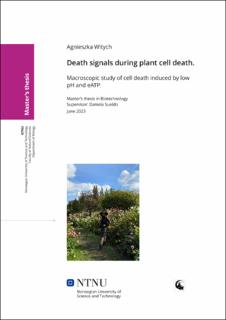| dc.contributor.advisor | Sueldo, Daniela | |
| dc.contributor.author | Witych, Agnieszka | |
| dc.date.accessioned | 2023-07-01T17:23:10Z | |
| dc.date.available | 2023-07-01T17:23:10Z | |
| dc.date.issued | 2023 | |
| dc.identifier | no.ntnu:inspera:146508044:99360890 | |
| dc.identifier.uri | https://hdl.handle.net/11250/3075217 | |
| dc.description.abstract | For tiden er forskning på celledød et utviklende og svært interessant tema. Celledød som dødsprosessen i mikroskala er en viktig kontrollmekanisme i alle levende organismer. Spesielt programmert cellulært "selvmord", som gjør det mulig å fjerne skadede celler som ikke lenger er nødvendige, er fascinerende. Med hver nye utgivelse får vi kunnskap om denne prosessen, både hos dyr og planter. Imidlertid er celledøden mekanismer relativt mindre godt forstått i planter. For optimal vekst og utvikling trenger planter for eksempel en passende pH i jorda. For lav pH i jorda er en stress utløser, som kan føre til celledød. I det siste har ekstracellulær ATP (eATP) dukket opp som et signalmolekyl i planter med flere roller i utvikling og stressrespons. Dessuten kan eATP frigjøres under celledød, men dens rolle som døde signal i planter er ikke godt forstått ennå. I denne masteroppgaven hadde jeg et mål for å svare på spørsmålet om lav pH og eksogen ATP forårsaker celledød i Arabidopsis thaliana. For å gjøre det, behandlet jeg frøplanter med ugunstig pH 4,6 i to forskjellige buffere, Sodium Acetate og MES buffer. Jeg observerte at lav pH er en utløser for celledød og indusert bleking i cotyledons og primære blader. Forresten ble det bleking undertrykt i mørket, noe som tyder på at disse responsene er lysavhengige. Dessuten for å undersøke om eATP kan det fungere som et "døds molekyl" i planter, behandlet jeg frøplanter med ATP på forskjellige tidspunkter. Resultatene fikk jeg avslørt at eATP induserte celledød på kortere tidspunkt (1 time). | |
| dc.description.abstract | Research in cell death is currently a developing and very interesting topic. Cell death as the process of death in microscale is an important mechanism of control in all living organisms. Especially programmed cellular ‘suicide', which allows to remove damaged cells that are no longer needed, is fascinating. With every new publication, we gain knowledge about this process, in both animals and plants. However, cell death mechanisms are comparatively less well understood in plants. For optimal growth and development plants need a suitable pH of the soil for instance. Too low pH in the soil is a stress trigger, which can lead to cell death. Recently, extracellular ATP (eATP) has emerged as a signaling molecule in plants with several roles in development and stress response. Furthermore, eATP can be released during cell death but its role as a death signal in plants is not well understood yet. In this master thesis I aimed to answer the question whether low pH and exogenous ATP cause cell death in Arabidopsis thaliana. For this, I treated seedlings with adverse pH 4.6 in two different buffers, Sodium Acetate and MES buffer. I observed that low pH is a trigger for cell death and induced bleaching in cotyledons and primary leaves. Interestingly, bleaching was suppressed in the dark, suggesting these responses are light-dependent. Furthermore, to investigate if eATP can act as a ‘death molecule’ in plants, I treated seedlings with ATP for different timepoints. The results I obtained revealed that eATP induced cell death at shorter timepoints (1 hour). | |
| dc.language | eng | |
| dc.publisher | NTNU | |
| dc.title | Death signals during plant cell death. Macroscopic study of cell death induced by low pH and eATP. | |
| dc.type | Master thesis | |
